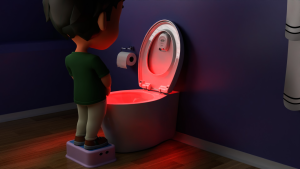The Text That Changed Everything
“Mom, I’m never getting married. Girls are too complicated about bathroom stuff.”

That’s what 8-year-old Tyler told his mother after overhearing his teenage brother’s girlfriend complain about the toilet seat being left up. What started as an innocent comment revealed a concerning truth: Tyler had never learned that his bathroom behavior affects others.
This story, shared by mother of three Lisa Chen, illustrates a critical gap in how we toilet train boys. While we celebrate their ability to use the toilet independently, we often miss teaching them the consideration and accuracy skills that prevent relationship conflicts, household tensions, and daily cleanup frustrations for years to come.
The earlier boys learn proper toilet etiquette, the more natural and automatic these behaviors become. Waiting until they’re older means breaking established habits rather than building good ones from the start.
The Hidden Costs of Skipping Etiquette Training for Boys
Most parents focus toilet training efforts on achieving basic bathroom independence – getting to the toilet on time and successfully using it. But for boys especially, this approach creates long-term challenges that affect the entire family:
The daily cleanup burden:
- Constant cleaning of toilet seats, floors, and surrounding surfaces
- Higher bathroom maintenance and sanitation requirements
- Increased household stress for primary cleaners (often mothers)
- Time and energy diverted from other family activities
The social consideration gap:
- Boys who never learn to consider the next bathroom user
- Future roommate and relationship conflicts over bathroom habits
- Missed opportunities to develop empathy and social awareness
- Reinforcement of “someone else will clean up after me” mentality
The accuracy challenge:
- Persistent mess issues that traditional toilet training doesn’t address
- Boys who see poor aim as acceptable or unavoidable
- Parents who assume “boys will be boys” rather than teaching precision
- Lost opportunities to build confidence through skill mastery
As we explored in our guide to teaching toilet seat etiquette, these issues stem from treating etiquette as optional rather than essential.
Why Boys Face Unique Toilet Training Challenges
Understanding the specific challenges boys encounter helps explain why targeted etiquette training is so crucial:
Physical differences:
- Standing vs. sitting: Boys must master both positions and know when each is appropriate
- Aim requirements: Accuracy becomes a necessary skill, not just a preference
- Seat positioning: Boys must learn to think about seat position for different bathroom functions
- Multi-step process: More complex decision-making required for each bathroom visit
Developmental factors:
- Later maturation: Boys often develop fine motor control and spatial awareness later than girls
- Impulse control: May rush through bathroom visits without considering consequences
- Social awareness: Often need explicit teaching about how their actions affect others
- Physical activity levels: Higher energy boys may struggle with precision and patience
Cultural influences:
- “Boys will be boys” mentality: Lower expectations for cleanliness and consideration
- Limited role modeling: Fewer opportunities to observe proper male bathroom etiquette
- Focus on independence over consideration: Emphasis on self-sufficiency rather than social responsibility
These factors combine to create a perfect storm where boys achieve basic toilet use but miss crucial etiquette and accuracy skills.
The Science Behind Early Habit Formation
Research in child development reveals why early etiquette training is far more effective than trying to correct established habits later:
Critical learning windows:
- Ages 2-5: Primary habit formation period when behaviors become automatic
- Neuroplasticity advantage: Young brains adapt quickly to new behavioral patterns
- Reduced resistance: Early learning feels natural rather than corrective
- Foundational building: Etiquette skills support broader social development
The cost of waiting:
- Habit entrenchment: Poor bathroom habits become increasingly difficult to change
- Identity formation: Boys may see messy bathroom behavior as part of their identity
- Increased resistance: Older children resist changes to established routines
- Social reinforcement: Peer groups may normalize poor bathroom habits
Early intervention prevents these complications while taking advantage of natural learning windows.
Real-World Success: The Martinez Family Transformation
The Martinez household exemplifies both the problem and the solution. With three boys ages 3, 5, and 7, bathroom visits consistently resulted in mess, forgotten seat positioning, and daily family stress.
“I was spending 20 minutes every day cleaning the bathroom,” explains father Carlos Martinez. “My wife and I were constantly frustrated, and the boys just didn’t understand why it mattered. They could use the toilet fine, why was everyone so upset about a little mess?”
The breakthrough came when they implemented a comprehensive approach combining etiquette education with visual feedback systems:
Week 1 Results:
- 5-year-old Miguel began checking seat position automatically
- 3-year-old Diego started treating accurate aim as a game
- 7-year-old Antonio took pride in teaching his brothers proper technique
- Daily cleanup time dropped from 20 minutes to 5 minutes
Month 1 Outcomes:
- Zero family conflicts over bathroom etiquette
- Boys reminding each other about proper behavior
- Guests commenting on the family’s well-maintained bathroom
- Parents able to trust boys with bathroom independence in any location
“The visual feedback system made all the difference,” Carlos continues. “Instead of us constantly nagging, the boys had immediate feedback about their accuracy and etiquette. It became a skill they wanted to master rather than rules they had to follow.”
As detailed in our comprehensive guide on how visual cues transform toilet training, immediate feedback creates lasting behavioral change far more effectively than verbal reminders.
The Target Practice Advantage: Making Accuracy Fun
One of the most effective approaches for boys is transforming accuracy challenges into engaging target practice:
Why target practice works for boys:
- Natural appeal: Most boys enjoy aiming and precision activities
- Immediate feedback: Success or failure is instantly apparent
- Skill building: Accuracy improves through practice and focus
- Confidence boost: Mastery creates pride and self-assurance
- Game-like engagement: Fun factor maintains motivation over time
Traditional vs. Target-Based Training:
Traditional approach:
- “Try to aim better”
- Focus on avoiding mess
- Correction after mistakes
- Cleanup as consequence
Target-based approach:
- Clear visual target to hit
- Focus on accuracy achievement
- Immediate success feedback
- Pride in precision skills
The difference in results is dramatic. Boys who learn through target practice typically achieve better long-term accuracy and take more pride in their bathroom skills.
Step-by-Step Boys-Specific Etiquette Training
Phase 1: Foundation Building (Week 1)
- Introduce the “bathroom citizenship” concept: Explain how good bathroom behavior helps the whole family
- Establish dual expectations: Both accuracy and etiquette matter equally
- Create positive associations: Frame skills as “big boy” achievements
- Visual feedback introduction: Let boys observe immediate responses to their behavior
Phase 2: Skill Development (Weeks 2-3)
- Target practice sessions: Make accuracy improvement a focused activity
- Etiquette checkpoints: Teach boys to pause and assess seat position before leaving
- Success celebration: Enthusiastically praise both accuracy and consideration
- Peer learning: Encourage brothers to help each other improve
Phase 3: Independence Building (Weeks 3-4)
- Self-monitoring development: Boys learn to assess their own performance
- Automatic behavior formation: Skills become natural rather than effortful
- Pride in mastery: Boys feel accomplished about their bathroom citizenship
- Family harmony: Reduced conflicts and increased mutual respect
Phase 4: Mastery and Maintenance (Ongoing)
- Consistent high standards: Maintain expectations for accuracy and etiquette
- Skill transfer: Apply lessons to different bathrooms and situations
- Leadership development: Older boys mentor younger siblings
- Long-term habit maintenance: Skills persist throughout childhood and beyond
Addressing Common Challenges in Boys’ Etiquette Training
Challenge: “He forgets to put the seat down” Solution: Visual feedback systems provide immediate reminders without parental nagging. Boys learn to check for proper positioning automatically.
Challenge: “The accuracy just isn’t improving” Solution: Target practice with immediate visual feedback transforms accuracy from abstract goal to concrete game. Most boys show rapid improvement when aiming becomes engaging.
Challenge: “He doesn’t understand why it matters” Solution: Connect etiquette to concrete benefits: “When you put the seat down, Mom doesn’t fall in at night” creates clear cause-and-effect understanding.
Challenge: “Older boys resist changing established habits” Solution: Frame changes as skill upgrades rather than corrections. Position new behaviors as advanced techniques for mature boys.
Challenge: “He’s careful at home but not elsewhere” Solution: Practice applying skills in different locations. Portable visual feedback tools ensure consistency across various bathrooms.
The Long-Term Relationship Benefits
Boys who learn proper toilet etiquette early gain advantages that extend far beyond childhood:
Future relationship success:
- Consideration habits: Automatic thoughtfulness about shared spaces
- Conflict prevention: Reduced tension over bathroom behavior
- Respect demonstration: Partners appreciate thoughtful bathroom citizenship
- Role modeling: Ability to teach proper behavior to their own children
Social and professional benefits:
- Shared living success: Better roommate and colleague relationships
- Personal presentation: Association with cleanliness and consideration
- Leadership opportunities: Others trust those who demonstrate responsibility
- Self-confidence: Pride in maintaining high personal standards
These benefits compound over decades, making early etiquette training one of the highest-value investments in a boy’s social development.
The Technology That Makes Training Effective
Modern toilet training aids have evolved far beyond basic potty seats to address the specific challenges boys face:
Key features for boys-specific training:
- Accuracy feedback: Visual indicators that respond to aim precision
- Etiquette reminders: Automatic cues about proper seat positioning
- Engagement elements: Game-like features that maintain motivation
- Independence building: Systems that work without parental supervision
- Skill progression: Tools that adapt as abilities improve
The Willy Light exemplifies this evolution, combining accuracy training with etiquette education through intuitive red/green visual feedback that makes proper bathroom behavior both clear and rewarding.

Beyond Training: Building Bathroom Leaders
The most successful boys’ etiquette programs don’t just create compliant bathroom users – they develop bathroom leaders who:
- Take pride in their skills: View accuracy and etiquette as personal achievements
- Help others learn: Share knowledge with siblings and friends
- Maintain high standards: Continue good habits without external motivation
- Problem-solve independently: Address challenges without parental intervention
- Model consideration: Demonstrate thoughtfulness in all shared spaces
These leadership qualities emerge naturally when boys master bathroom citizenship early and thoroughly.
Making the Investment in Your Son’s Future
Consider the long-term implications of toilet training decisions:
The cost of incomplete training:
- Years of daily cleanup and reminders
- Family stress and bathroom conflicts
- Missed opportunities for consideration development
- Future relationship and social challenges
- Reinforcement of inconsiderate behavior patterns
The value of comprehensive etiquette training:
- Rapid development of accuracy and consideration skills
- Elimination of daily bathroom battles and cleanup burdens
- Building of lifelong social and relationship advantages
- Development of leadership and responsibility qualities
- Enhanced family harmony and mutual respect
Early investment in proper training pays dividends for decades.
Transform Your Son’s Bathroom Behavior Today
Your son has learned to use the toilet – now it’s time to master the complete bathroom experience. Don’t let crucial etiquette and accuracy skills develop by chance or through years of reminders and corrections.
Ready to give your son the social and practical skills he needs for lifelong success?
The Willy Light’s innovative visual feedback system makes boys-specific toilet training both effective and engaging. Target practice becomes automatic, etiquette checks become habit, and bathroom citizenship becomes a source of pride rather than family conflict.
See how visual feedback transforms boys’ bathroom behavior. Discover why thousands of families have chosen comprehensive training that addresses accuracy, etiquette, and consideration together – because raising thoughtful, capable young men starts with the fundamentals.
Visit our website at https://www.willylight.com.au/ to learn how the Willy Light can eliminate bathroom struggles while building the social skills your son will need throughout his entire life. Your family’s harmony and your son’s future relationships depend on the habits he builds today.




